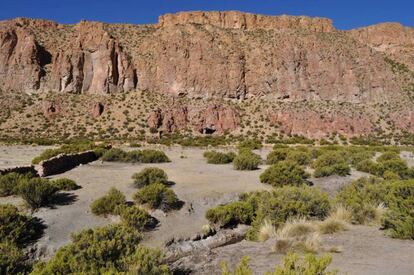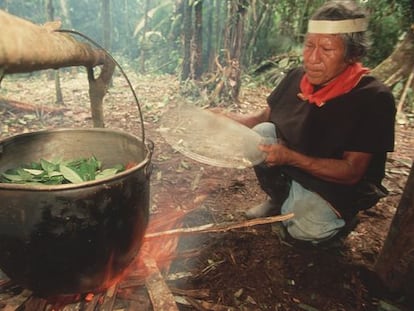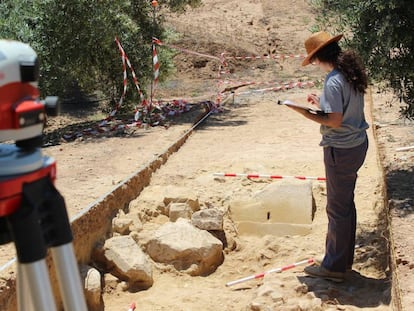Cocaine and ancient hallucinogens discovered in 1,000-year-old shamanic pouch
Utensils found at a site in Bolivia had traces of benzoylecgonine, bufotenine and the two main ingredients of the traditional spiritual medicine ayahuasca

Around 1,000 years ago, at an altitude of around 4,000 meters, a member of a community knowledgeable in plants and their psychotropic uses was buried in a cave, in what is now Sur L¨ªpez province in southwestern Bolivia. The tomb was desecrated some time later and there was no sign of his body when it was excavated. But the rock shelter, known as the Cuevo del Chileno, which had been occupied by humans for 4,000 years and had excellent conditions for conserving organic material, had preserved something else ¨C a 1,000-year-old leather pouch.
Almost all the plants used to make ayahuasca are tropical and they would have had to travel hundreds of kilometers to get them
Researcher Jos¨¦ Capriles
Inside the pouch were various utensils designed for the consumption of indigenous drugs ¨C two wooden boards to inhale substances, a tube used to breathe them in, two spatulas fashioned from llama bone, a headband, pieces of dried plants and a small bag sewn from three foxes¡¯ noses. The chemical analysis of these artifacts suggests that people had the necessary knowledge at that time to make ayahuasca ¨C a traditional psyochoactive brew used in spiritual ceremonies by peoples indigenous to the Amazonian Basin of South America.
Two of the drink¡¯s main ingredients were found at the site ¨C harmine, which is a fluorescent harmala alkaloid belonging to the beta-carboline family of compounds that can usually be got from the banesteriopsis caapi vine, and the shrub known as psychotria viridis which contains the hallucinogen component dimethyltryptamine (DMT). There were also remains of cocaine and benzoylecgonine, which suggests that there had been coca leaves, as well as traces of bufotenine, another hallucinogen that can be concocted from the seeds of the anadenanthera colubrina tree and which would have been inhaled after being crushed on the wooden boards.
What is surprising is that none of the plants would have grown at the altitude of the burial site. ¡°Almost all the plants used to make ayahuasca are tropical and they would have had to travel hundreds of kilometers to get them,¡± says Jos¨¦ Capriles, a researcher at Penn State University who led the research and recently published a paper on the discovery in the journal PNAS. ¡°There was a lot of llama caravan traffic and many communities began to develop on account of long-distance commercial trading.

¡°The ingestion of these psychotropic drugs gives us some idea of the extensive networks that these people could access. Besides being important for rituals, the use of these products would have brought social prestige, it would be a sign of the community¡¯s ability to move across great distances; or of having great wealth and the necessary contacts to obtain them, given they came from so far away,¡± says Capriles.
Santiago L¨®pez-Pavillard, author of the book?Chamanes, ayahuasca y sanaci¨®n (or, Chamans, Ayahuasca and Healing) says the data indicates the vast phytopharmacological knowledge that the tribes from the Amazonian basin possessed 1,000 years ago. It would have been general knowledge and would have existed at all altitudes, connected as they were by extensive trading networks. He also believes that the sample discovered in Bolivia could have come from the upper Orinoco Basin in the south of Venezuela.
People learn about the properties of plants by ingesting them; it is the plants themselves that teach human beings about their properties Author Santiago L¨®pez-Pavillard
What remains a mystery is how these indigenous tribes gathered the knowledge to prepare ayahuasca or knew which plants to choose from out of the more than 80,000 in their ecosystem. ¡°To understand how they got this knowledge of plants, we have to assume the existence of a kind of animist cognitive anthropology which gives us the expression ¡®master plant¡¯ [in reference to ayahuasca],¡± says L¨®pez-Pavillard. ¡°People learn about the properties of plants by ingesting them; it is the plants themselves that teach human beings about their properties and what other plants they can combine with. This is the procedure that is still followed today in the Amazon forest by those who wish to train as shamans.¡±
The knowledge may have been acquired over thousands of years of trial and error. The analysis of mommies from the Tihuanaco civilization ¨C a culture that existed before the Incas in the Andean region between 1,600 and 1,100 years ago ¨C found the remains of harmine in the hair of both a child and an adult. Harmine was used at that time as a medicine because it has psychoactive properties that are not hallucinogenic. The inclusion of other plants to trigger psychedelic spiritual visions could have come later.
The shaman¡¯s artifacts belong to an era when the Tihuanaco civilization was in decline. Some studies have linked ceremonial aspects such as the inhalation boards with rituals and customs that were used to extend the culture into other regions. Those in charge of these rituals were probably the most influential members of these ancient Andean tribes. By using these substances, they could be in touch with the gods and even turn themselves into the animals they believed represented the deities.
But there are an increasing number of researchers who believed the hallucinogenic substances had a wider use. ¡°It is likely that some of the substances were taken in different ways,¡± says Capriles.
Nowadays, in some regions of South America, experiences with ayahuasca are advertised as a form of entertainment.
English version by Heather Galloway.
Tu suscripci¨®n se est¨¢ usando en otro dispositivo
?Quieres a?adir otro usuario a tu suscripci¨®n?
Si contin¨²as leyendo en este dispositivo, no se podr¨¢ leer en el otro.
FlechaTu suscripci¨®n se est¨¢ usando en otro dispositivo y solo puedes acceder a EL PA?S desde un dispositivo a la vez.
Si quieres compartir tu cuenta, cambia tu suscripci¨®n a la modalidad Premium, as¨ª podr¨¢s a?adir otro usuario. Cada uno acceder¨¢ con su propia cuenta de email, lo que os permitir¨¢ personalizar vuestra experiencia en EL PA?S.
En el caso de no saber qui¨¦n est¨¢ usando tu cuenta, te recomendamos cambiar tu contrase?a aqu¨ª.
Si decides continuar compartiendo tu cuenta, este mensaje se mostrar¨¢ en tu dispositivo y en el de la otra persona que est¨¢ usando tu cuenta de forma indefinida, afectando a tu experiencia de lectura. Puedes consultar aqu¨ª los t¨¦rminos y condiciones de la suscripci¨®n digital.










































